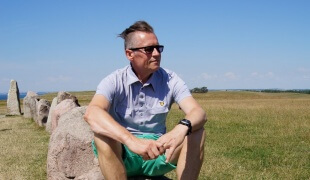Being a Creative Director can be a hugely enjoyable experience. There are days when the client is loving the work, the studio is buzzing and the sun is shining. Then there are the days when you’re on your own, you feel the ideas aren’t up to scratch and you’re questioning your worth.
Experience can help you to a point. However, to use a car analogy, you can’t keep driving without stopping for fuel.
This is where looking and seeing comes in. We all travel to and from work on a daily basis, but how many of us actually see the ‘stuff’ around us? For those of us who need to keep the engine topped up it’s imperative that we ‘see the everyday’ that surrounds us. How many of us have driven a familiar route only to arrive at the destination and not recall getting there? Neurologist David Eagleman believes time shrinks for something you do often (commute) but the longer your brain takes to process information (new things), the longer time feels. This is one reason why a weekend away can feel longer than an average weekend at home. Now I’m not saying you want to shrink or expand time but taking a different route to your place of work might help you notice different things or the same things differently.
To prove the point of looking and seeing, a recent study asked 85 UCLA undergraduates to draw the Apple logo from memory. Only one was able to draw the image correctly. Every one of the undergraduates will have seen the Apple logo, many on a daily basis. But only one had seen it!

Taking the theory one step further - last year I picked up several Autumn leaves, with a view to scanning them and selecting the colours of the leaves from the scan. I expected a range of oranges and browns. What did I find? Oranges and browns. And acidic greens, bright yellows and fiery reds. The debate between what I found and the visual vernacular of Autumn is best saved for another post; the point I’m making here is that you might be surprised and stimulated by what you see, as opposed to relying on what you think you’ll see.
A good analogy of seeing what others don’t see is that of observational humour. The comedian sees the everyday in a different, hopefully humorous, light. For the audience there will be the ‘oh yeah’ moment, as a common truth is revealed. Only by seeing will you find the ‘oh yeah’ moments for your audience.
Chris Baréz-Brown (Upping Your Elvis) and David Pearl (Pearl Group) have recently developed an outdoor learning session based on seeing what’s around you in everyday life. ‘Street Wisdom’, is a three hour experience that uses the streets and surrounding environment to answer attendees’ questions. This might be about life, work or an inspirational breakthrough that is required. How? Simply through seeing what’s around us, everyday, in a different way. ‘It’s a simple idea, based on the proposition that the environment and people around us are full of wisdom we largely overlook or ignore. Street Wisdom allows us to tune into the rich stimulus and learn. As our strapline says – answers are everywhere – you just have to ask’.

Here at Multiply, we make it our job to not only look at, but also to see what’s out there. That might be the way people navigate the local supermarket (shopper), what stories are resonating with consumers (brand) or how folk are communicating online with a brand (digital). Our NPD (new product development) workshops are a particular favourite as this gives us the opportunity to work with clients (Heinz and Camelot amongst others) to see the potential for new products or portfolio extensions and how they will fit into their/the consumer’s world.
You can carry out market research but this doesn’t tell the full story and is often skewed as you lose the context of the brand, environment and purchase intent. You really need to see the world as it is.
Next time you need refuelled you need to see what’s right in front of you. Our everyday world around us is an amazing and inspiring place - if you choose to see it.


